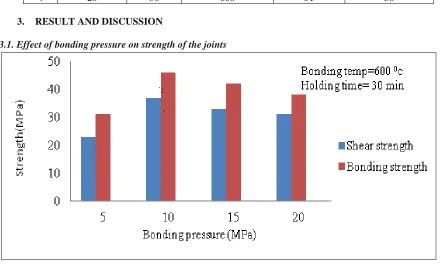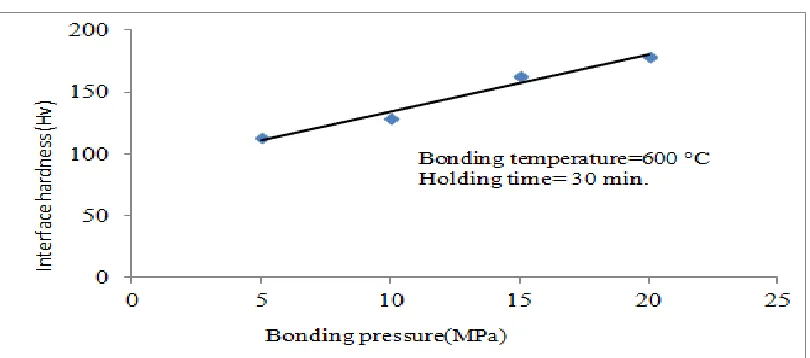238
Influence of Bonding Pressure on Characteristics of
Diffusion Bonded P/M Cu- Ni Bimetallic Joints
A. Murugan
1, T. Senthilvelan
2, V. Balasubramanian
31
Department of Mechanical Engineering, Shri Krishnaa College of Engineering and Technology, Puducherry 605501, India
2Department of Mechanical Engineering, Pondicherry Engineering College,
Puducherry 605 014, India,
3
Centre for Materials Joining and Research (CEMAJOR), Department of Manufacturing Engineering,Annamalai University,Annamalai Nagar, 608 002, Tamil Nadu, India
E-mail: a_murugaa@rediffmail.com
Abstract-In this investigation, pure Copper (Cu) and pure Nickel (Ni) plates manufactured by powder metallurgy (P/M) technique were bonded by diffusion bonding process. The bonding strength of the diffusion bonded joint is influenced by three important process parameters such as Bonding temperature, Bonding pressure and Holding time. This investigation was carried out to understand the effect of bonding pressure on the characteristics of diffusion bonded pure Cu-Ni bimetallic joints. The experiments were conducted by varying the pressure between 5-20 MPa and the bonding temperature and the holding time were kept constant. The bonding quality was checked by
microstructure analysis using optical microscope (OM) and scanning electron micrographs (SEM). The XRD analysis
was carried out to confirm the compounds formation and the phase analysis.The shear strength and bonding strength
of the bonds were evaluated by conducting lap shear test and ram tensile test respectively. The interface hardness of the bonds was measured by Vicker’s hardness test
Key words: Pure Copper, Pure Nickel, Powder Metallurgy, Diffusion bonding, Characteristics of Bond
1. INTRODUCTION
Diffusion bonding is a solid - state joining process and it is used for making components in electronic, nuclear and aerospace industries [1, 2]. Copper has excellent features such as high electrical conductivity, thermal conductivity and hence used in power industries, electrical appliances machinery and automobiles [3]. Nickel has high corrosion resistance at high temperature and it possesses substantial solid solubility with copper which enhance the properties of the joints [4, 5]. It has been used in the fuelcell that is used in the power generation for hospital .Joining dissimilar materials by traditional fusion welding technique causes severe thermal cracking and easy formation of brittle intermetallic compounds in the bond region [4]. Therefore, welding of these dissimilar materials by fusion welding technique is difficult Hence the diffusion bonding technique is used to join these materials. The bonding pressure, bonding temperature and holding time are the predominant process parameters of diffusion bonding [5].
Diffusion is promoted by high temperature since adhesion is necessary for the bonding process [6]. The excessive heating decreases the bonding strength
due to the formation of residual stress. The bonding pressure should be sufficient to make enough tight contact between the joining surfaces of the materials and to fill the void in the weld zone. Also the bonding time could be sufficient for intimate contact between the materials [7,8,9]. However, the effect of bonding pressure on diffusion bonding of pure copper and Nickel were analysed and the details are presented in this paper
2. EXPERIMENTAL WORK
Square shaped specimens (50 mmx50 mm) were manufactured from pure Ni and pure Cu by powder metallurgy (P/M) technique. The prepared specimen thickness of Cu was 5 mm and Ni was 4 mm. The specimens prepared by P/M technique and these were machined to make flat surfaces by milling and then cleaned in acetone just before diffusion bonding. The polished and chemically treated specimens were stacked in the die which was made by 316 L stainless steel. The specimens were heated up to the bonding temperature by
induction furnace. The required pressure was
E-ISSN: 2321-9637
Available online at www.ijrat.org
239
were cooled to the room temperature before removal from the chamber of diffusion bonding machine. By this way, four joints were fabricated by keeping the bonding temperature and holding time were kept in constant and varying the bonding pressure as mentioned in the table1. The hardness of diffusion layer was measured by using Vicker’s hardness tester. The microstructure analysis
was carefully carried out to exhibit the formation of diffusion layer and its thickness was measured at the interface of the joints using optical microscope and scanning electron microscopy. The copper side was
etched by a solution containing ethanol, FeCl3
concentrated HCL, whereas the Ni side was etched by using ammonium persulfate to reveal the microstructure.
Table 1.Experimental conditions of Cu/Ni diffusion bonds
Joint
3.1. Effect of bonding pressure on strength of the joints
From the Fig.1 it is understood that shear strength and bonding strength of the bonds increase with increasing of bonding pressure, irrespective of bonding temperature and holding time. At low bonding pressure of 5 Mpa, shear strength and bonding strength are minimum, because at low bonding pressure, the voids are present in the interface region and the contact rates between the materials is less and also diffusion between the materials is less. When the
240
1.2. Effect of bonding pressure on Interface hardness
Fig. 2. Interface hardness From the Fig. 2, it is understood that the interface
hardness of the joints increase with increase in bonding pressure. The property of the bonded joints mainly depends on thickness of the intermetallic compounds [10].At low bonding pressure of 5 MPa, interface hardness are minimum. Because the formation of intermetallic compounds at the interface of the bond is minimum and also volume fraction of reaction products is more [11-13].When it is increased to 10 MPa, plastic deformation will develop at contact sites to increase the
E-ISSN: 2321-9637
Available online at www.ijrat.org
241
2.3. Effect of bonding pressure on diffusion layer thickness
From the Fig.3. it can be inferred that the formation
diffusivity of copper and aluminium together is less quantity and the formation of intermetallic compounds is also very less. These cause very thin diffusion layer. Further increase of bonding pressure till 20 MPa the diffusion layer thickness will
gradually increase with bonding pressure.
4. CHARACTERISATION OF DIFFUSION BONDED JOINTS
Optical micrographs and scanning electron micrographs were taken at the interface region of the Cu/Ni bonds to understand the effect of bonding pressure on the formation of diffusion layer and the interface. From the scanning electron micrographs and optical micrographs, it is observed that when the diffusion bonding occurs between two dissimilar materials, the new phases from the base metals are found in the diffusion layer. The brittle intermetallic compounds formed in diffusion layer would be weaken the bonding performance. Hence, it is important to analyse the formation and growth of intermetallic compounds at the interface region in order to control the process during the diffusion bonding of dissimilar materials [14].
The intermetallic contain the phases of Cu-Ni, CuO,Cu2O, Fe2Ni ,Al2Cu ,NiC, Ni2O which were identified by using XRD shown in fig. 5. A very thin layer of thickness 19 m was formed under the bonding
temperature of 600 ºC, holding time of 30 minute and bonding pressure of 5 MPa .This interface exhibited shear strength and bonding strength of 19 MPa and 24 MPa respectively. A medium thick diffusion layer of 25 m was formed under the bonding temperature of 600 ºC, holding time of 30 minutes and bonding pressure of 10 MPa. This interface exhibited shear and bonding strength of 37 MPa and 46 MPa, respectively. A very thick diffusion layer of 32 m was formed under the bonding temperature of 600 ºC, holding time of 30 minutes and bonding pressure of 20 MPa which exhibited shear and bonding strength of 28 MPa and 34 MPa, respectively. It is observed from the Fig .4 (a-c) & (d-f) that when the bonding pressure increases,the diffusion layer thickness increases and the maximum shear and bonding strength are obtained due to formation optimum diffusion layer thickness.
242
(a) Thin layer (d) Thin layer
(b) Medium layer (e) Medium layer
(c) Thick layer (f) Thick layer
Fig. 4. Optical and SEM micrographs of Cu/Ni bonds (a-c: OM; d-f: SEM)
Ni
Cu
DL
Cu
Ni
DL
Cu
Ni
DL
Ni
Cu
20μmDL
Ni
Cu 20μm
DL
Ni
Cu 20μm
E-ISSN: 2321-9637
Available online at www.ijrat.org
243
Fig. 5. EDS results at the interface region of Cu/Ni bonds
5. CONCLUSIONS
From this investigation, the following conclusions are obtained bonding pressure of 10 MPa at bonding temperature of 600 °C and holding time 30 minutes after which then these strengths decrease
ACKNOWLEDGMENTS
The authors are grateful to the Centre for Materials Joining and Research (CEMAJOR), Department of Manufacturing Engineering, Annamalai University, Annamalai Nagar, India for extending the facilities
REFERENCES
1] Lee CS; Li. Chandel, RS;(2008), Simulation model
for the vacuum - free diffusion bonding of aluminium metal matrix composite. J Mat Process Tech , 89-90: 344-349.
[2] Gao, Y; Wang, C.; Pang H, Liu H, Yau; M (2007), Broad beam laser cladding of Al-Cu alloy coating on AZ91HP magnesium alloy. App Surf Sci , 253: 4917-4922.
[3] Xu, R; Tang D, Ren; X, Wang X, Wen ;Y(2007), Improvement of the matrix and the interface quality of a Cu/Al composite by the MARB process. Rare Metals, 26(3): 230.
[4] Sabetghadam, H; Zarei, A; Hanzaki A; Araee, (2010),Diffusion bonding of 410 stainless steel to
copper using nickel a interlayer. Mat.Char., 61:62-63
[5] Howlader, MMR; Kaga, T; Suga,; (2007);
Investigation of bonding strength and sealing behavior of aluminum/stainless steel bonded at
room temperature.Vacuum, 84: 1334 -1340.
[6 [6] Ho-Sung Lee, Jong-Hoon Yoon, Yeong-Moo Yi (2007), “Oxidation behavior of titanium alloy
under diffusion bonding”, Thermochimica
Acta,vol.455,105-108.
[7] Halil Arik, Mustafa Aydin, Adem Kurt, Mehmet Turker (2005),Al4C3-Al composites via diffusion
welding technique”, Materials and Design, vol. 26, 555-560.
[8] Tanabe, J;, Sasaki, T;, Kishi,S;(2007), “Diffusion bonding of Ti/graphite and Ti/diamond by hot isostatic pressing method”, Mat.Pro.Tech, vol. 192-193 , 453- 458.
[9] Hill, P. S; Todd, R. I., Ridley, N;
(2003),”Mechanism of HIP bonding of Zircaloy-4 in the α-phase field”, Mat.Pro.Tech,135 , 131-136.
[10] Feng, JC; Zhang, BG; Qian, YY; He, P; (2002) Micro Structure and strength of diffusion-bonded joints of Ti Al base alloy to steel, Material Characterization, 48: 401-406.
[11] Mahendran,G; Balasubramanian, V; Senthilvelan T; (2010) Influences of diffusion bonding process parameters on bond characteristics of Mg-Cu dissimilar joints, Transaction of Nonferrous Metals China, 20:997-1005.
[12] Chunhuan Chen, Xiaojing Liu, Xiujuan Zhao, Ruiming Ren(2012), The Effects of Intermediate Layer and Surface Nanocrystallization on the Vacuum Diffusion Bonding of Commercially Pure Titanium. Physics Procedia., 63 - 67.
[ 13] Kenevisi, M S;, Mousavi Khoie, S M;(2012), A
244
Properties of Al7075 to Ti–6Al–4VDiffusion Bonded Joint. Mat Letters. ,144-146
[14] He, P; Liu, D; (2006) Mechanism of forming interfacial intermetallic compounds at interface for



